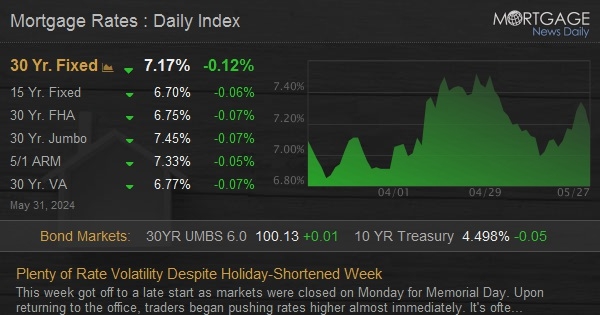This week got off to a late start as markets were closed on Monday for Memorial Day. Upon returning to the office, traders began pushing rates higher almost immediately.
It’s often said that the bond market can experience elevated, seemingly random volatility amid the lighter trading participation seen on the days surrounding 3-day weekends. Tuesday may have been a good example as it brought the biggest move of the week despite an absence of high consequence data.
That’s not to say that data was completely absent. Traders digested comments from several Fed speakers with the most memorable example coming from Minneapolis Fed’s Kashkari who said he’d need to see “many” more months of good inflation data before the Fed would consider cutting rates. This is a departure from the average Fed speaker who uses words like “several” to discuss the same dependency.
In addition to Fed comments, there was a condensed schedule of Treasury auctions. These regularly scheduled auctions account for the “supply” side of supply and demand in the bond market. Higher supply means lower prices and higher rates, all other things being equal. In this case, the amount of supply is published well in advance, but the auction process provides a temperature check for investor demand. The relatively lower demand at this week’s auctions also played a role in pushing rates higher in the first two days.
Things began to improve on Thursday–not only because auctions were over, but also due to rate-friendly revisions in the quarterly GDP data. Finally, Friday’s PCE inflation data helped add momentum to Thursday’s recovery.

The PCE price index is similar to the Consumer Price Index (CPI). Both are official government measures of inflation. PCE is released 2 weeks after CPI. As such, it tends to produce less volatility, but the Fed actually prefers it to CPI when it comes to assessing the 2% inflation target.

Clearly, progress toward the 2% target has slowed, but it is also technically continuing. When we look at the monthly version of the same data, we can see that the continuation wasn’t necessarily a given based on how the numbers came out in the first quarter. January, specifically, was alarming. If January numbers were repeated for 12 months, the annual inflation level would be closer to 6% as opposed to just under 3%.
Feb/Mar reports were lower, but still suggested an annualized inflation level well over 3%. This week’s data (for the month of April) is still nowhere near the lower readings seen last year, but it showed more progress in the right direction after January’s scare.

Mortgage rates haven’t calmed down as fast as the rest of the bond market. Mortgage rate volatility was even more elevated due to the structure of the underlying mortgage market causing some pricing overlap when rates move through levels ending in .125% or .625%. To simplify a very complicated explanation, there’s very little difference between 7.125% and 7.25% as far as most lenders are concerned. As such, when rates move up past 7.125%, the next viable stop is 7.375%, even if the underlying market movement would normally only have pushed rates up to 7.25%.

The housing market continues expressing its lack of enjoyment of 7%+ mortgage rates. The most recent evidence was this week’s Pending Home Sales Index from the National Association of Realtors.

In the week ahead, the potential volatility only increases as we’ll get several top tier economic reports. Apart from Thursday, every day of the week has a scheduled report with the power to move markets by at least as much as any of this past week’s data. Friday’s jobs report is particularly potent, even if not quite in the same league as the Consumer Price Index (CPI) these days.
Source link
#Plenty #Rate #Volatility #HolidayShortened #Week



